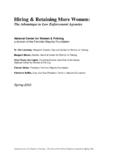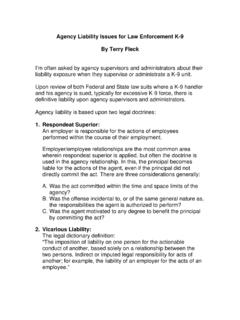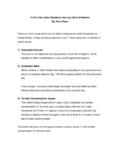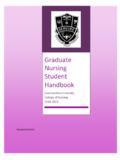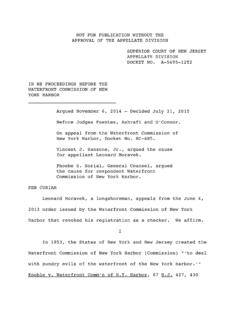Transcription of TEARING DOWN THE WALL - Women and Policing
1 National Center for Women & Policing , a Division of the Feminist Majority Foundation, Spring 2003 TEARING down THE WALL: PROBLEMS WITH CONSISTENCY, VALIDITY, AND ADVERSE IMPACT OF PHYSICAL AGILITY TESTING IN police SELECTION National Center for Women & Policing a division of the Feminist Majority Foundation Dr. Kim Lonsway, Research Director, National Center for Women & Policing Katherine Spillar, Executive Vice-President, Feminist Majority Foundation Sharyn Tejani, Legal Director, Feminist Majority Foundation Patricia Aguirre, Hannah Dupes Research Associates, National Center for Women & Policing Margaret Moore, Director, National Center for Women & Policing Chief Penny Harrington, Founding Director and Chair of the Board, National Center for Women & Policing Eleanor Smeal, President, Feminist Majority Foundation Spring 2003 THE FULL REPORT OF THIS RESEARCH IS SCHEDULED TO APPEAR IN police QUARTERLY (2003), ISSUE #3.
2 TEARING down the Wall: Physical Agility Testing in police Selection Page 2 National Center for Women & Policing , a Division of the Feminist Majority Foundation, Spring 2003 TEARING down THE WALL: PROBLEMS WITH CONSISTENCY, VALIDITY, AND ADVERSE IMPACT OF PHYSICAL AGILITY TESTING IN police SELECTION he job of Policing is widely assumed to require a great deal of physical prowess, and this is often used to keep Women out of law enforcement jobs. The mythology and accompanying physical mandates for law enforcement candidates persist despite a voluminous body of research that documents the sedentary nature of police work and poor physical fitness among in-service law enforcement personnel.
3 This summary report briefly reviews the existing literature on Women 's performance as police officers, the physical demands of police work, and the use of physical agility testing in police selection. A survey was conducted with 62 police agencies to provide information regarding their physical agility testing protocol and representation of Women within sworn personnel. Results indicate that the vast majority (89%) utilize some form of physical agility testing for entry-level selection. The study also documents that agencies without a test have 45% more sworn Women than those with such a test ( vs. ). Results also demonstrate a striking lack of agreement or standardization -- regarding the physical capabilities that should be tested and the criteria that should be used to evaluate successful performance.
4 This summary report concludes by reviewing alternatives for physical agility testing in police officer selection. T TEARING down the Wall: Physical Agility Testing in police Selection Page 3 National Center for Women & Policing , a Division of the Feminist Majority Foundation, Spring 2003 INTRODUCTION Until the late 1970's, many police agencies utilized minimal height requirements and weight standards as part of their selection criteria. These standards screened out a disproportionate number of Women from the selection process, but failed to predict either the safety or successful performance of officers in terms of injuries, citizen complaints, accidents, assaults, and The courts therefore rejected such standards as discriminatory under Title VII of the 1964 Civil Rights Since that time, physical agility tests have largely replaced the old height and weight standards as a screening device for police officer candidates.
5 These tests typically also have a negative impact on Women . In fact, the negative effect of physical agility testing on Women is often so severe that some commentators have speculated that its very purpose is to screen out female applicants across the board. Yet research has consistently documented that Women not only perform the job of Policing as successfully as their male colleagues, but also that female officers utilize a style of Policing that relies less on physical force and more on communications As a result, Women are often better at defusing potentially violent confrontations, and are less likely to become involved in use of excessive force situations (see footnote 3).
6 In fact, no matter which measure of excessive force is used -- citizen complaints, sustained allegations, or civil liability payouts -- the pattern is both dramatic and consistent. Women are substantially less likely to be named in a citizen complaint, sustained allegation, or civil lawsuit for excessive use of Thus, the under-representation of Women in Policing is a significant contributing factor to the problem of police brutality that plagues agencies across the country and damages police -citizen relations. The under-representation of Women in law enforcement also has significant implications for Women in the community who are victims of domestic violence. Research shows that Women officers respond more effectively to domestic violence incidents which constitute approximately half of all violent crime calls to the police .
7 Moreover, studies have found that up to 40% of police officers commit domestic abuse themselves. In other words, 4 in 10 officers responding to the scene of a domestic violence incident may themselves be abusers (see footnote 3). The overall quality of police response to cases of violence against Women would almost certainly improve by increasing the numbers of Women in law enforcement. To recruit successful female officers, however, it is critical that police agencies remedy the disproportionate negative impact of physical agility testing on Women versus men in the selection process. The EEOC states that adverse impact of a selection test is established when a plaintiff documents that passing rates for Women fall below 80% of men' At that point, the legal burden shifts to the police agency to prove that the test is job related and consistent with business necessity, and that it represents the least discriminatory alternative for selection.
8 Even if an agency successfully defends the job relatedness and business necessity of its physical test, it will still be legally liable if a plaintiff is able to show that an alternative exists that serves 1 Evans, (1980). Height, weight, and physical agility requirements -- Title VII and public safety employment. Journal of police Science and Administration, 8 (4), 414-436. 2 Dothard v. Rawlinson, 433 321(1977). 3 For a review of the research on the many advantages that Women bring to Policing , see Hiring and retaining more Women : The advantages to law enforcement agencies, prepared by the National Center for Women & Policing .
9 Available at 4 Lonsway, K., Wood, M. & Spillar, K. (2002). Men, Women and police excessive force: A tale of two genders. Manuscript to appear in December issue of Law & Order magazine. 5 Equal Employment Opportunity Commission, 29 CFR Ch. XIV, Subpart D, 7-1-01 Edition. TEARING down the Wall: Physical Agility Testing in police Selection Page 4 National Center for Women & Policing , a Division of the Feminist Majority Foundation, Spring 2003 the employer s business needs but has less adverse For a detailed review of the various strategies used by police agencies to demonstrate the job relatedness of their physical agility test, see the corresponding technical NATIONAL REVIEW OF PHYSICAL AGILITY TESTING In light of the issues reviewed above, research was conducted to document the prevalence of physical agility testing in a random sample of law enforcement agencies.
10 To determine whether such testing is associated with a decreased representation of sworn Women , and to study whether there was any consensus as to the physical abilities that should be examined and the cutoff scores required. As part of the 2001 Status of Women in Policing Survey, a random sample of 360 law enforcement agencies was identified from the 1997 Law Enforcement Management and Administrative Statistics8 as having 100 or more sworn officers. Of these 360 agencies, 257 responded with information regarding their representation of Women , for an excellent response rate of These 257 agencies were then surveyed regarding their physical agility testing protocol.

